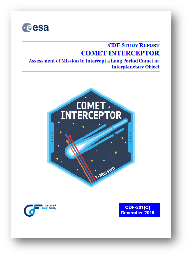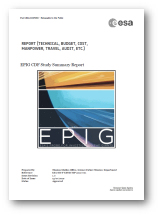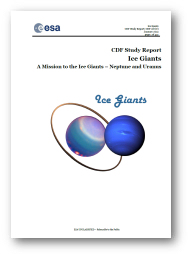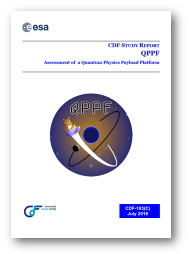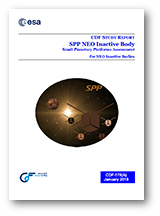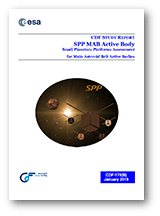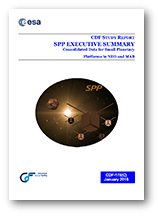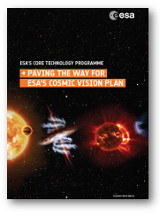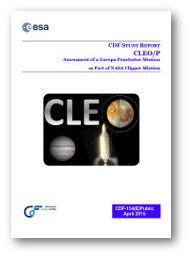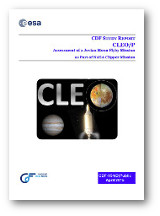ESA Science & Technology - Publication Archive
Publication archive
Publication archive
Reference: ESA-SPI-EST-MIS-RP-001
SPICA (SPace Infrared telescope for Cosmology and Astrophysics) is a far IR telescope to study and answer fundamental astrophysical questions ranging from the formation and evolution of galaxies to the physics of star formation in dusty environments, including the role of magnetic fields, and the origin of planetary systems.
The SPICA mission was conceived as a cooperation between ESA and JAXA and it was initially selected as a candidate for the Cosmic Vision M5 mission together with THESEUS and EnVision. In the course of Phase A, it appeared that, although technical feasibility could be demonstrated, SPICA cost at completion was exceeding the boundaries of an M-class mission. Therefore, ESA, JAXA and SRON jointly decided to withdraw the mission from the M5 selection.
However, the Phase A was completed. The technical outcome is documented in the following report which may be used as guidance and reference for future studies.
Document reference: CDF-201(C)
In July 2018, ESA issued to the science community a Call for a Fast (F) mission opportunity in ESA's Science Programme. After a two-phase review process the Comet Interceptor mission was selected in June 2019 for going into the study phase, starting with a Concurrent Design Facility (CDF) mission assessment study.
The Comet Interceptor spacecraft will be launched in 2028 towards the Sun-Earth second Lagrange point, L2, on-board an Ariane 6.2 as co-passenger to the Ariel mission. The mission aims to intercept in a fly-by scenario a Long Period Comet (LPC), with Dynamically New Comets (DNCs) representing the highest priority type of LPC, or an interstellar body passing through our Solar System. The mission includes three elements, one main spacecraft (ESA) and two probes (one ESA and one JAXA) carried as payloads until the fly-by, at which point they are released to gather multi-point observations of the comet and its coma.
This second Comet Interceptor study carries on from the first Comet Interceptor study performed in the ESA CDF in early 2019. The second study was carried out by an interdisciplinary team of experts from ESA with the participation of JAXA and the mission proposer team in six sessions and two extra delta sessions, between October and December 2019.
Document reference: ESA-SCI-F-ESTEC-RP-2019-001
The EPIG (ESA Probe for Investigation of the Giants) CDF study explored the feasibility of a European "stand-alone" mission to the Ice Giants (or Saturn as back-up). It corresponds to an ESA internal assessment of the capabilities to use only European technology to explore the outer planets.
The study was carried out by an interdisciplinary team of experts from ESA in eight sessions, starting with a kick-off on 28 March 2019 and ending with an Internal Final Presentation on 9 May 2019. This is a summary report of the EPIG CDF study. The full CDF study report will be made available at a later date.
Document reference: CDF-187(C)
A mission to the Ice Giants (Neptune and Uranus) will be among the ones examined by the next Planetary Sciences Decadal, which also fits with the potential launch opportunity, with a Jupiter swing-by, that would allow to reach both planets by launching in the early 2030s.
ESA is exploring potential contributions to a NASA-led mission to the ice giants aimed at understanding the interior structure and bulk composition of the planet(s), including isotopes and noble gases.
ESA and NASA agreed to study a palette of possible configurations of varying cost to ESA and complexity, keeping in mind the need for clear interfaces.
It is important to keep this background in mind and remember that this study is not analysing a specific science proposal but trying to understand potential contributions following a top-down approach.
Requested by SCI-FM and funded by GSP, the M* (Ice Giants) study was set to analyse the feasibility of "stand-alone" elements provided by ESA to be part of the NASA-led mission to Uranus, Neptune and their moons (M-class mission budget but not proposed following a Cosmic Vision Programme Call, hence M*).
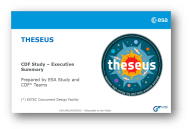 |
The internal Phase 0 study of the M5 mission candidate THESEUS has been performed at ESA's Concurrent Design Facility (CDF) between June and November 2018. An internal final presentation has been prepared by the CDF Team, summarizing the outcome of the Phase 0 study. This presentation can be downloaded as a PDF (10 MB) by clicking the image to the right, or the 'link to publication' link below.
The internal final presentations of the internal Phase 0 studies of the other two M5 mission candidates, EnVision and SPICA, are also available.
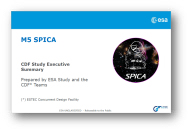 |
The internal Phase 0 study of the M5 mission candidate SPICA has been performed at ESA's Concurrent Design Facility (CDF) between June and November 2018. An internal final presentation has been prepared by the CDF Team, summarizing the outcome of the Phase 0 study. This presentation can be downloaded as a PDF (6 MB) by clicking the image to the right, or the 'link to publication' link below.
The internal final presentations of the internal Phase 0 studies of the other two M5 mission candidates, EnVision and THESEUS, are also available.
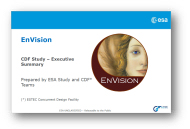 |
The internal Phase 0 study of the M5 mission candidate EnVision has been performed at ESA's Concurrent Design Facility (CDF) between June and November 2018. An internal final presentation has been prepared by the CDF Team, summarizing the outcome of the Phase 0 study. This presentation can be downloaded as a PDF (10 MB) by clicking the image to the right, or the 'link to publication' link below.
The internal final presentations of the internal Phase 0 studies of the other two M5 mission candidates, SPICA and THESEUS, are also available.
Document reference: CDF-183(C)
ESA's Concurrent Design Facility (CDF) has completed an assessment study of the Quantum Physics PlatForm: a mission concept to test the quantum superposition principle with "massive" test particles. ESA's Science Directorate requested and managed the study as one of three topics selected for investigation following the "New Science Ideas" call for proposals.
The concept studied was a proposal to perform quantum decoherence measurements with particles of more than 109 atomic mass units.
The main goal of the study was to provide a reference mission design for such a quantum physics experiment, and to inform the community of the ESA process of requirements engineering in view of future calls for missions in ESA's Science Programme.
ESA's Concurrent Design Facility (CDF) has completed an assessment study of Small Planetary Platforms (SPP): small mission concepts that include a mothercraft and a swarm of small satellites that can be deployed. ESA's Science Directorate requested and managed the study as one of three topics selected for investigation following the "New Science Ideas" call for proposals.
The concept studied was a proposal to perform multi-point (and possibly multi-target) measurements around small bodies (asteroids and comets), as well as Mars or Venus, to gather information from different locations simultaneously.
The main goal of the study was not to design a specific mission but to provide a "tool-box" of technical building blocks the community can use to develop these new planetary mission architectures, in reply to future science calls.
The full CDF study report consists of three main reports, each available in pdf format below:
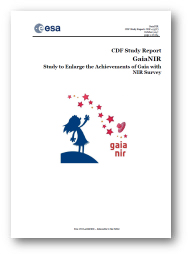
Document reference: CDF-175(C)
This document is the assessment study report for GaiaNIR (Gaia Near Infra-Red), which was one of the proposals received in response to the 2016 Call for New Science Ideas in ESA's Science Programme. Three mission concepts were selected as a result of this call, and GaiaNIR was one of them.
The GaiaNIR proposal encompasses:
- Enlarging the astrometric achievement of Gaia to the astronomical sources which are only visible in Near Infra-Red
- Maintaining the accuracy of the Gaia optical reference frame
- Improving the star parallax and proper motion accuracy by revisiting the astronomical sources a number of years after Gaia.
Corrigendum:
This document was updated on 8 June 2018, with minor edits made to page 249 according to the final version of the document. The concerned lines are indicated by a blue band on the side of that page.
This brochure acts as a guide to ESA's Core Technology Programme and how it supports the Cosmic Vision Plan – ESA's mechanism for the long-term planning of space science missions.
The information featured here describes how the science directorate ensures that the technology needed to make these ground-breaking missions a reality is ready when needed. It also outlines the work the Core Technology Programme has already done toward some of the most ambitious missions in ESA's history.
Document reference: CDF-154(E)
This document is the assessment study report for CLEP, the Clipper Europa ESA Penetrator mission, which could be a part of the NASA Clipper mission.
As the junior partner to the Clipper mission ESA are considering a potential mission of opportunity that could be considered by the science community in future mission proposals, to either carry out fly-bys of the Jupiter Moon Io — the subject of another study — or Europa, or possibly to impact Europa — the subject of this study.
The assignment was to formulate a penetrator concept, with high velocity impact on Europa and subsurface investigation, including a life detection experiment, for a possible ESA contribution to the NASA Clipper mission and to evaluate its feasibility. Full details are available in the report.
The report has been prepared by the ESA concurrent design facility.
Document reference: CDF-154(D)
This document is the assessment study report for CLEO/P, a Jovian moon flyby mission that could be part of the NASA Clipper mission.
As the junior partner to the Clipper mission ESA are considering a potential mission of opportunity that could be considered by the science community in future mission proposals, to either carry out fly-bys of the Jupiter Moon Io — the subject of this study — or Europa, or possibly to impact Europa — the subject of a separate study.
This particular study was performed to formulate a small satellite (250 kg) concept. The main premise was to have this small satellite attached to Clipper during launch and interplanetary transfer and released by Clipper once it arrived at the Jovian system. Full details are available in the report.
The report has been prepared by the ESA concurrent design facility.
This document presents the results of a study, performed by ESA's Concurrent Design Facility (CDF) in 2014, that analysed the feasibility of a 150 kg-class rover compliant with a potential Mars Sample Return mission and its "FAST" mobility performance requirements. The rover is also able to provide in-situ science for supporting future Mars robotic exploration. For this study, a landing platform delivered by NASA/JPL was considered, in the view of a possible ESA/NASA cooperation in the 2024 timeframe.
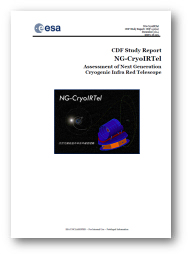 |
ESA's Concurrent Design Facility (CDF) have completed a study of a Next Generation-Cryogenic cooled InfraRed Telescope (NG-CryoIRTel). The purpose of this study is to support the European and Japanese science community in defining a post-SPICA mission for the Cosmic Vision M5 call. Full details of the study can be found in this report.
This document presents the results of the CDF study performed in 2014, that analysed the feasibility of a joint ESA-ROSCOSMOS Phobos sample return mission. It was performed by an interdisciplinary team composed of specialists from ESA, IKI (RU) and Lavochkin (RU).
Our understanding of the Universe has come under increased scrutiny over the last 25 years. New instruments have opened fascinating perspectives for testing General Relativity, alternative theories of gravitation, as well as studying quantum mechanics and exploring the boundaries of quantum gravity. Violations of the principle laws of the currently underlying theories can give clues to aid the unification of the four physical forces, or lead the way for the discovery of new interactions and particles.
The aim of the Fundamental Physics Explorer (FPE) is to provide the means to test the the foundations of modern physics in a cost effective and efficient manner. The FPE programme could consist of up to three spacecrafts, each re-using a small platform, accessing space to take advantage of an almost constantly unperturbed environment, thus improving the precision of current measurements. More specifically, the FPE Technology Reference Study (TRS) aims to identify the key technologies required and the technical challenges associated with fundamental physics missions.
Link to publication Study Overview
Link to publication Mission Analysis Annex

